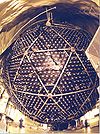- MINERνA
-
Main Injector Experiment for ν-A, or MINERνA, is a neutrino scattering experiment which uses the NuMI beamline at Fermilab. MINERνA seeks to measure low energy neutrino interactions both in support of neutrino oscillation experiments and also to study the strong dynamics of the nucleon and nucleus that affect these interactions.[1]
Status
The first detector module was completed in early 2006,[1] and the first events were observed by the partially-assembled detector in April 2009.[2][3] Construction was completed in January, and the detector was installed in March 2010.[4][5]
Detector
The detector used for the MINERvA experiment weighs 5 tons[6] and is made of many layers of parallel scintillator strips. Each strip is connected to a photomultiplier tube which is used to detect the amount of energy deposited into the strip. The orientation of the strips varies from layer to layer so that three dimensional information about where incoming particles interacted with the strip can be determined.
References
- ^ a b MINERνA home page, retrieved 5 Oct 2007
- ^ Wisniewski, Rhianna (2009-04-03). "MINERvA opens eyes to neutrino data". Fermilab Today. http://www.fnal.gov/pub/today/archive_2009/today09-04-03.html. Retrieved 2010-06-11.
- ^ "MINERvA Sees!". MINERvA at Fermilab. 2009-04-01. http://minerva.fnal.gov/news/MINERvA-Sees/minerva-sees.html. Retrieved 2010-06-11.
- ^ "Intensity Frontier". Fermilab. 2010-03-24. http://www.fnal.gov/pub/science/experiments/intensity/minerva.html. Retrieved 2010-06-11.
- ^ "Status of the MINERvA detector construction". Fermilab. http://minerva.fnal.gov/news/constructionStatus.html. Retrieved 2010-06-11.
- ^ http://www.fnal.gov/pub/today/archive_2006/today06-02-15.html
Neutrino detectors, experiments, and facilities Discoveries 
Operating Construction Retired Proposed Cancelled See also Categories:- Accelerator neutrino experiments
- Physics stubs
Wikimedia Foundation. 2010.
